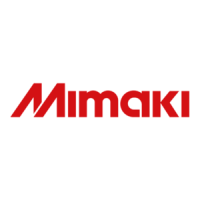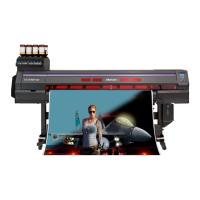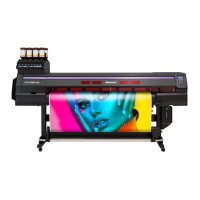What to do if ink leakage occurs in MIMAKI UCJV300-160 Printer?
- FfjenkinsSep 13, 2025
If ink leakage occurs in your MIMAKI Printer, immediately turn off the main power and unplug the power cable. Contact your local dealer or our service office.

What to do if ink leakage occurs in MIMAKI UCJV300-160 Printer?
If ink leakage occurs in your MIMAKI Printer, immediately turn off the main power and unplug the power cable. Contact your local dealer or our service office.
| Maximum Print Width | 1, 610 mm |
|---|---|
| Resolution | 1200 x 1200 dpi |
| Ink Type | UV-curable ink |
| Cutting Function | Yes |
| Media Thickness | Up to 1 mm (0.04") |
| Media Width | 1, 620 mm (63.8") |
| Connectivity | USB2.0, Ethernet |
| Print Speed | Up to 25.8 m²/h |
| Print Technology | UV-LED Inkjet |
Covers liability limitations, fire risks, and general safety warnings.
Addresses potential electromagnetic interference and mitigation steps.
Details compliance with Federal Communications Commission regulations.
Explains the meaning of warning, caution, and notice symbols used in the manual.
Provides essential safety guidelines for operating the machine and handling liquids.
Outlines critical requirements for safe and proper installation environments.
Describes safety interlock features and locations of warning labels on the machine.
Details safety measures for handling ink, cleaning solutions, and waste ink.
Provides information on ink types, capacity, expiration, and storage conditions.
Specifies the necessary clearance around the machine for operation and maintenance.
Provides instructions and precautions for moving the machine.
Identifies and describes the main parts and components of the printer.
Details the procedure for connecting the power cable and turning the machine on/off.
Explains how to connect the printer to a PC using USB or LAN interfaces.
Guides through the initial setup of the printer system, including RIP software.
Provides instructions for replacing ink bottles and managing ink levels.
Outlines the step-by-step process for performing a print job.
Explains how to adjust the gap between the print head and the platen for optimal printing.
Details how to position pinch rollers for different media widths.
Provides instructions for loading both roll and leaf media onto the printer.
Guides on configuring pinch roller settings for various media and tools.
Explains how to perform test prints to check ink quality and identify defects.
Describes different head cleaning procedures for resolving print defects.
Explains how to adjust media feed amounts to correct printing defects.
Details how to adjust the drop position for bi-directional printing to improve accuracy.
Guides on preparing and sending print data from RIP software.
Explains the procedure for cutting media after printing.
Outlines the steps involved in performing a cutting job.
Provides instructions for installing cutters and pens in the machine.
Explains how to configure speed, pressure, and offset for cutting.
Guides on performing test cuts to verify settings and quality.
Details how to set up and initiate cutting jobs.
Outlines the workflow for cutting based on printed register marks.
Explains how to create and use register marks for accurate cutting.
Details how to configure settings for detecting printed register marks.
Explains the procedure for identifying the origin point of register marks.
Describes the process for using ID Cut data for automated cutting.
Covers setting print conditions for specific media and temporary usage.
Details various maintenance actions and nozzle recovery functions.
Explains settings for auto power-off, media detection, and network configuration.
Covers nozzle clogging detection and automatic recovery settings.
Provides access to machine status, usage, and version information.
Details settings for register mark detection, cut modes, and offsets.
Essential guidelines for performing maintenance safely and effectively.
Lists routine cleaning and inspection tasks to be performed daily and weekly.
Lists necessary tools and consumable items for maintenance.
Step-by-step guide for cleaning the print head wiper.
Instructions for cleaning the printer's cap to maintain nozzle health.
Details how to clean the Nozzle Check Unit sensor.
Guides on cleaning the underside of the carriage and UV-LED lamp.
Explains how to clean or replace the mist filter.
Describes nozzle washing to resolve print defects when cleaning fails.
Provides instructions for cleaning the ink discharge channel.
Details how to clean the media sensors for accurate detection.
Explains how to clean the media holder for proper media feeding.
Guides on cleaning the platen area to ensure proper media handling.
Instructions for cleaning the external covers of the machine.
Provides guidelines for preparing the machine for long-term storage.
Covers replacement procedures for wipers, caps, filters, and rollers.
Details replacement for cutting-specific consumables like cutters and pen lines.
Provides solutions for common problems like power, printing, and media issues.
Lists error and warning messages with their causes and corrective actions.
Lists technical specifications for the printer models.
Details specifications related to the cutting functionality.











